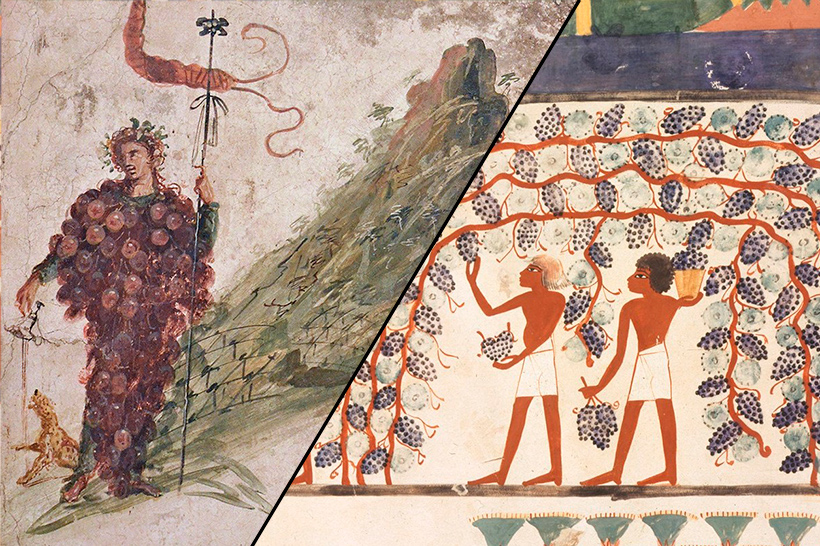Hittite rhytons, Egyptian tomb paintings, Greek vases, Roman mosaics – all these art forms depicted wine in ancient civilisations. Together we run through the history of wine in the first part of my Wine in Art series
Wine is many things to many people but above all it is a cultural phenomenon. In Wine and Other Stories, I investigate wine’s numerous ties to human history, society and art. For this reason, I’m proud to present to you a new series of articles, called Wine in Art, where l explore how wine has been represented in various forms of art throughout history.
What you are currently reading is the first part of the Wine in Art series in which I focus on ancient civilizations. In terms of chronology, this article will look at wine in art in ancient history spanning from the beginning of recorded time to just before the Middle Ages (around 500 AD).
The beginning – Hittite, Sumer and Georgia
We can’t pinpoint the exact moment in history when wine was first invented (or discovered). However, if we accept grape pips as evidence of winemaking in ancient civilizations (like most archaeologists do), then it’s fair to trace wine’s origin back to circa 8000 BC. A few places in Eastern Europe and the Middle East contend for the title of being the first country where wine was made; these are Turkey, Syria, Lebanon, Jordan, Armenia and Georgia.
However, to see wine portrayed in pictorial art we have to wait a few millennia. The first known illustration of wine drinking is probably contained in The Standard of Ur – a Sumerian artefact dating back to around 2500 BC.
The Standard of Ur is a rectangular wood box covered with a mosaic of shell, red limestone and lapis lazuli. The box is divided into two panels, one depicting a victorious military campaign and the other portraying a peaceful banquet scene. The latter shows a group of people, including what appears to be a king, sitting at a table and being served by attendants. The scene includes a variety of food and drinks.

There is no conclusive evidence that the drink shown on The Standard of Ur is wine. Nevertheless, wine had paramount importance in ancient Sumerian culture. Also for Sumerians, wine was the appointed drink for kings and leaders. For these reasons, it is reasonable to assume that the beverage we see on the Standard of Ur is indeed wine.
After the Sumerians came the mysterious Hittites who occupied Anatolia in the second millennium BC. It’s known that the Hittites used wine during religious rituals and royal matters. Archaeologists have found elaborate chalices and rhytons (a type of drinking container typically having the form of an animal’s head or a horn) which were used to serve wine.

In ancient Mesopotamia, wine was represented in artefacts such as cylinder seals (although used for administrative purposes, they also served as a form of art and many seals depict scenes of wine production and consumption), relieves and pottery (ceramic vessels decorated with images of grapes, vines and other symbols associated with wine).

Just north of Mesopotamia, between 2000 and 1500 BC the Trialeti-Vanadzor culture flourished in Eastern Georgia. In the large burial mounds (called “Kurgans”) found at Trialeti, researchers discovered splendidly ornate gold and silver goblets, often depicting drinking scenes or ceremonies. Once again, these artefacts highlight the importance that wine had within the ancient Georgian culture.

Wine in ancient Egypt
While ancient Egyptians were not the first to grow vines, their historical records about wine and winemaking are astonishing. Wine was an important part of daily life in ancient Egypt. From 3000 BC to 1000 BC, Egyptians left a plethora of evidence on how they produced, stored, labelled and consumed wine.
Ancient Egyptians depicted wine in art in various forms, perhaps the most important was the tomb paintings of the time. These tomb paintings often contained scenes of wine production and consumption, showing people of high status, such as pharaohs and their courtiers, enjoying wine. They also outlined the winemaking process, such as the use of wine presses and storing wine in large jars called amphorae.

Reliefs were another common form of art in ancient Egypt in which wine was portrayed. These large, sculpted carvings were often used to decorate the walls of temples, tombs and palaces. Many reliefs had scenes of banquets, which showed wine being consumed and enjoyed.
Ancient Egyptian pottery was also another art form where wine was celebrated. Some vases were decorated with images of grapes, vines and other tools linked with wine, such as wine jugs or presses. While a lot of these vases were used for practical purposes, such as holding wine and other liquids, they were also decorative objects.

Greece: from Crete to Athens
Ancient Egyptians travelled throughout the western world. While roaming the Mediterranean, they introduced winemaking to the Minoan civilization (a bronze-age Greek civilization founded around the island of Crete). The Mycenaeans, the first advanced civilisation of mainland Greece, learned about winemaking from the Minoans.
The ancient Greeks proceeded to develop and perfect the art of winemaking, and wine became an important part of their culture and society. Wine was used in religious rituals as well as in social and cultural gatherings (such as the famous “symposia”).
One of the earliest forms of wine representation in ancient Greek art was pottery. Greek vases often show scenes of wine drinking and winemaking. These vases were used for both practical and decorative purposes. They often depicted the ancient and powerful god of wine, Dionysus, and his association with wine. The scenes represented on these vases also include people drinking wine during banquets, symposia and everyday life.
Some examples of famous Greek vases that depict wine are the Francois Vase, the “Krater of Euphronios” (515 BC circa) and the “Kylix of Douris” (480 BC circa).

In addition to pottery, sculpture also played a role in the artistic representation of wine. Statues of Dionysus were common in ancient Greece. These depicted Dionysos as a bearded, robed figure holding a thyrsus, a staff entwined with ivy and grapes, symbolising his connection to wine and fertility.

Another way in which wine was represented in ancient Greek art was through painting and mosaics. The ancient Greeks were skilled painters and used their talents to create frescoes and murals depicting winemaking and scenes of wine consumption. These paintings were often found in the homes of the wealthy, as well as in public spaces such as taverns and inns.

From Athens to Rome
From the 800 BC, a number of Greek city-states colonised south Italy, creating the so-called Magna Grecia. More or less in the same period, further north in Italy, the ancient Roman civilization was born.
Ancient Roman culture owed a great deal to Greece. Athens was often seen as the model of cultural and social sophistication. Greek influence was huge in several areas such as trade, administration, philosophy, science and art. Therefore it is no surprise that the artistic representations of wine in ancient Rome followed (when they didn’t copy) their Hellenic counterparts. As such, ancient Romans also scattered references to wine in their pottery, sculpture, mosaic and painting.
Bacchus (the Roman equivalent of Dionysus) is portrayed in many Roman sculptures, some of them are inspired or even actual copies of former Greek specimens. The Roman representation of Bacchus contained the same symbols as its Greek counterparts: the thyrsus, grape bunches or wine cups. Bacchus is represented either as an old bearded man or a young feminine man.

Roman Imperial Period (1st – 2nd century AD) – National Museums Liverpool
Mosaic is another art form that the Romans borrowed (and according to many scholars even improved) from the ancient Greeks. Numerous Roman mosaics had images of Bacchus, while others illustrated winemaking scenes such as harvest or wine consumption in various fashions.

Wall paintings in ancient Rome served the same purpose as mosaics. In that period, wealthy families loved having the walls of their opulent houses and villas decorated with frescoes. Popular frescoes included scenes of people eating and drinking or Greek and Roman gods (such as Bacchus).

During the rise of Rome, another civilisation dominated central and north Italy: the Etruscans. Although Roman and Etruscan civilisations merged in the 4th century BC, it’s important to note that the Etruscans had their distinctive society and art forms.
Although it’s not clear who introduced wine to Etruscans, they did have a strong culture of wine. The latter dominated Etruscan artistic representations, especially their tomb paintings. These paintings often depicted lively banquets and the consumption of wine.

A glimpse to the east: ancient China
While my article on Wine in Art focuses on western ancient civilisations, it’s worth highlighting that we have archaeological evidence suggesting that wine was also present in ancient China.
Wine is depicted in various forms of ancient Chinese art, including pottery, bronze vessels and paintings. Frequently, wine vessels were decorated with intricate designs which were highly prized by the wealthy and elite.
One of the most famous artistic representations of wine in ancient China is the famous Zhou wine container. It’s a bronze vessel that dates back to the Western Zhou period (circa 1050-771 BC). This bronze vessel was found in the tomb of a high-ranking official.
In many ancient Chinese paintings, wine is often depicted as a symbol of wealth and luxury, and is associated with banquet scenes, music and poetry.

Conclusion
Wine has been seducing civilisations for more than eight millennia. Through the rise and fall of ancient civilisations, wine has maintained a special place in each culture that came to know this beverage. Art often depicted wine as a symbol of veneration, wealth, luxury and celebration.
In this first part of my Wine in Art series, I explored how wine was represented in art during ancient history. In the following articles of the series, I will move ahead in time, looking at wine in art from the Middle Ages to the Renaissance, until the modern age.
Before you leave this article to organise your personal symposium, why don’t you subscribe to my newsletter (see below) to receive updates about the Wine in Art follow-ups and other articles?

